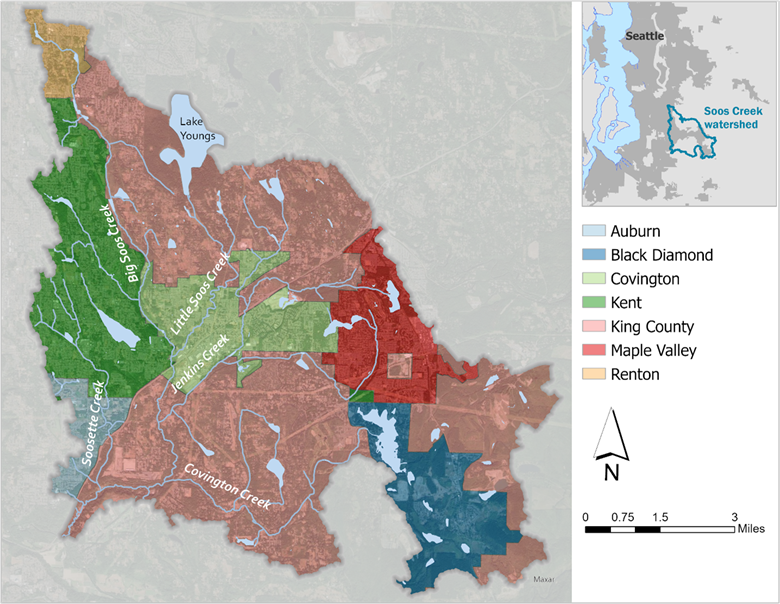Soos Creek watershed multi-parameter TMDL
The Soos Creek watershed is located in south King County, in the Seattle Metropolitan Area. The watershed includes several urbanizing, fast growing communities, including Covington, portions of Kent, Auburn, Maple Valley, Black Diamond, and Renton, and unincorporated King County.
Many of the streams in the watershed do not meet state water quality standards. We are developing a water quality improvement plan, also known as Total Maximum Daily Load (TMDL), to address impairments related to water temperature, dissolved oxygen, and bacteria in these streams. A separate water quality study that looks more closely at fine sediment impairments in Soos Creek is currently under development.
Water quality issues
The Soos Creek watershed is made up of the mainstem, Big Soos Creek, and its tributaries, including Soosette, Little Soos, Jenkins, and Covington creeks. Some of these streams do not meet water quality standards for temperature, dissolved oxygen, and bacteria.
/SalmonSoos.jpg?ext=.jpg)
Salmon waiting to enter the Soos Creek hatchery
Temperature and dissolved oxygen issues
Logging that started in the late 1800s, agriculture, and urban and industrial development have all changed the watershed's landscape. These changes have degraded the water quality so the watershed can’t fully support human activities and aquatic species, including salmon. Temperature changes, along with excess nutrients and sediment from fertilizers, waste, and erosion, have also decreased the amount of dissolved oxygen in the water. These conditions impair the habitat for cold-water aquatic species, especially salmon. The Soos Creek watershed is home to several species of salmon:
- Chinook
- Coho
- Chum
- Steelhead
Bacteria pollution
Increased development and agricultural practices can result in additional pressures on the water quality of streams in the Soos watershed. These can be sources of bacterial pollution, which endanger the health of humans or animals that come in contact with the polluted water.
What has been done
In 2006, we initiated a TMDL for temperature and dissolved oxygen. Data collection started in 2007. In 2012, we partnered with the Environmental Protection Agency (EPA), EPA contractor Tetra Tech, King County, and the Muckleshoot Indian Tribe to develop a water quality model to determine the causes and possible solutions to the temperature and dissolved oxygen impairments. During the same year, we initiated a separate study for bacterial pollution. In spite of progress made on these projects, a lack of resources delayed finalizing the projects.
In 2019, the project was revived. To examine questions about water quality in the downstream section of Big Soos Creek, in 2020 we monitored temperature and dissolved oxygen in Big Soos Creek above and below the Soos Creek hatchery. This monitoring effort and a close review of the existing model indicated that, to fully answer questions about the factors that control water quality, we need to broaden the scope of our analysis and use modeling tools that require additional data collection.
Status of the project
In light of these findings, we made the decision to conduct a comprehensive data collection for all three parameters and use a dynamic model that will help us determine sources of pollution and outline restoration actions. In 2023, we plan to develop a Quality Assurance Project Plan and conduct monitoring for temperature, dissolved oxygen, and E. coli bacteria. We estimate that the project will be wrapped up in 2026.
What we all can do
As we work on developing the water quality improvement plan, you can help improve water quality in Soos Creek by adopting some of these strategies:
- Reduce the use of pesticides and fertilizers and prevent overwatering of lawns
- Use natural lawn care products
- Install rain gardens to help with rainwater infiltration
- Use ecological cleaning products such as phosphate-free detergents
- Ensure a properly functioning on-site sewage system
- Keep livestock away from surface waters
- Dispose pet waste properly
- Plant trees, especially along streams
- Keep as much native vegetation and undisturbed land as practicable
- Wash cars on lawns or use a commercial car wash
- Practice “only rain down the drain” for stormwater conveyances
For more information, see Washington Waters — Ours to Protect. Check the map below to see if you live in a jurisdiction in the Soos Creek watershed.

Why this matters
Water temperature influences what organisms can live in a water body. Many types of aquatic life in the Pacific Northwest, including salmon species, have evolved to be best adapted to cold streams. This means that when stream temperatures increase too much, they disrupt normal metabolic processes for the salmon, putting these species at higher risk of disease, low reproduction rates, and even mortality. Cooler water can also hold more dissolved oxygen that fish and other aquatic life need to breathe.
Oxygen dissolved in water is vital for fish and aquatic life to “breathe”. It is more difficult to "breathe" oxygen from water than it is to breathe oxygen from air. Therefore, it is critical that an adequate amount of oxygen is available in the water for this transfer to take place efficiently and sustain aquatic life. Adequate concentrations of dissolved oxygen are critical at all life stages of salmonids and other species, and warmer water generally has less oxygen. Improving dissolved oxygen is an important target for a successful salmon habitat restoration in Soos Creek. Oxygen also helps decompose organic matter in the water and bottom sediment and is necessary for other biological and chemical processes.
E. coli is a type of bacteria common in human and animal waste. Its presence in streams indicates that sewage or manure is entering the water body. Bacteria can get into water from untreated or partially treated discharges from wastewater treatment plants, from improperly functioning septic systems, or from livestock, pets, and wildlife.
Related links
Contact information
Cleo Neculae
Water Quality Specialist
cleo.neculae@ecy.wa.gov
206-594-0138

